- Continue Shopping
- Your cart is empty
Regional Styles
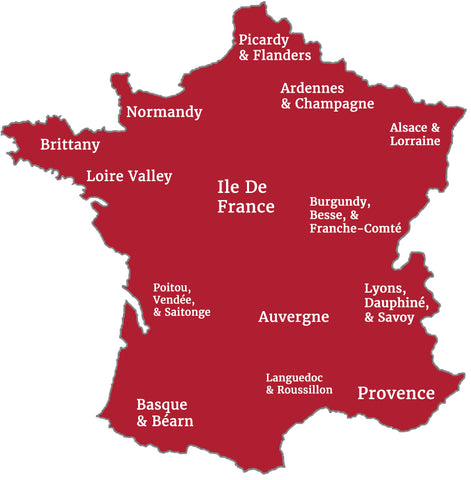 Select a region name below to learn more:
Select a region name below to learn more:
Normandy
 Elaborate carving is a distinctive feature of Norman furniture pieces, especially in the region's most representative piece, the armoire. Themes of love and prosperity were widely used in the 18th and 19th centuries with hearts, arrows, and lovebirds conveying the former, while cornucopia, grapes, wheat sheaves, and flowers symbolized the latter. Other typical designs included acanthus leaves, geometric patterns, farm implements, musical instruments, and anchors.
Elaborate carving is a distinctive feature of Norman furniture pieces, especially in the region's most representative piece, the armoire. Themes of love and prosperity were widely used in the 18th and 19th centuries with hearts, arrows, and lovebirds conveying the former, while cornucopia, grapes, wheat sheaves, and flowers symbolized the latter. Other typical designs included acanthus leaves, geometric patterns, farm implements, musical instruments, and anchors.
Cornices were generally flat and by the late 18th century began rounding upward in a chapeau de gendarme, or policeman's hat shape, usually decorated with deep three- dimensional carving. A significant characteristic of the armoire doors is the richly carved central traverse, with an elliptical medallion, either vertical or at an angle, as its most prevalent motif. The Normandy armoire features decorative metalwork of wrought iron, copper, or brass and the feet are usually curved ending in snail shells and small sabots.
The Norman people were particularly attracted to the symbols of the Louis XVI era, which extolled the ideals of marriage, family, and conjugal happiness. These themes carried through in the majority of their furniture pieces for the home except for the Norman table, which favored straight lines, stout construction, and utility of service.
Brittany
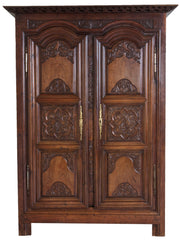 The Celtic roots of Brittany are manifest in the furniture produced in this region. The Breton style is as distinctive as its special culture. Overall it combines magnitude with a square ness of shape and richness in decoration that brings in geometric, floral, animal or human motifs in an original an imaginative country style. The Bretons have displayed a great love of ornamentation, and often they have been unable to resist adding their chiseled details to a piece made for them by a local woodworker. The results can be delightfully naive yet at the same time practical and whimsical in style.
The Celtic roots of Brittany are manifest in the furniture produced in this region. The Breton style is as distinctive as its special culture. Overall it combines magnitude with a square ness of shape and richness in decoration that brings in geometric, floral, animal or human motifs in an original an imaginative country style. The Bretons have displayed a great love of ornamentation, and often they have been unable to resist adding their chiseled details to a piece made for them by a local woodworker. The results can be delightfully naive yet at the same time practical and whimsical in style.
Carvings tend to be in light relief with mainly rectilinear edges. The influence of the Louis XV style is much less prevalent in Brittany than in other regions of France. In fact, apart from the curved feet, the square shape and straight lines predominate.
The Breton armoire is either very simple or ornately decorated with allegorical scenes or motifs. The Breton carvers preferred stylized floral bouquets and branches, interlacing geometrical patterns, religious emblems, animals, human figures, village scenes, marriages, dances or episodes from the histories of the saints.
A departure from the square outline Breton form can be found in the furniture pieces from the city of Rennes. The double chapeau de gendarme cornice with intricate carving and distinctive brass escutcheons readily identifies the work of this city.
The Bretons, like the Normans, embrace a simple, no nonsense approach to their tables of sparse decoration with emphasis on function.
Loire Valley
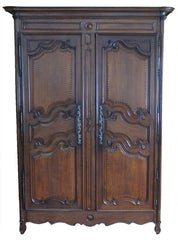 The Loire Valley is France's fairytale country. The Loire River Valley is home to the summer castles of the French kings and court. Furniture of the Loire was greatly influenced by the style of the Parisian court with Louis XV having the most dramatic impact. In the furniture of this region we see the urban influences of the court modified to impart a country feel. Armoires and buffets from this region are known for their sophisticated style and finish with a discreet use of ornamentation. The tables from this region are typically rectangular with turned legs connected by H- or X-shaped stretchers.
The Loire Valley is France's fairytale country. The Loire River Valley is home to the summer castles of the French kings and court. Furniture of the Loire was greatly influenced by the style of the Parisian court with Louis XV having the most dramatic impact. In the furniture of this region we see the urban influences of the court modified to impart a country feel. Armoires and buffets from this region are known for their sophisticated style and finish with a discreet use of ornamentation. The tables from this region are typically rectangular with turned legs connected by H- or X-shaped stretchers.
Poitou, Vendée and Saintonge
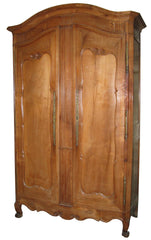 This large region is regarded by some as the spiritual home of classic provincial furniture. For here, more than anywhere, the craftsmen, carpenters, joiners, and artisans achieved a subtle balance between the fashionably stylish and the basically rustic, while retaining local characteristics.
This large region is regarded by some as the spiritual home of classic provincial furniture. For here, more than anywhere, the craftsmen, carpenters, joiners, and artisans achieved a subtle balance between the fashionably stylish and the basically rustic, while retaining local characteristics.
This large region is known for an enormous selection of woods used to make furniture with cherry, ash, pear, white walnut, chestnut, and burr elm being the woodworker's favorites. Armoires and buffets alike sport chantourné (turned on all sides) panels and highly decorative brass escutcheons providing dramatic visual impact. This region's size and location caused it to be influenced stylistically by both the north and the south, adding to the mix of inventive touches paired with traditional themes. One peculiar aspect of armoires from this region is the elimination of the decorative door transverse. The long door panels accentuate the height of the piece thus giving more emphasis to surrounding moldings and intricacy of the traditional exaggerated escutcheons.
Basque and Béarn
 Furniture from this region is strongly influenced by its proximity to Spain. Decorative metalwork is reduced to a minimum, with no elaborate or elongated escutcheons. Pieces from this region rely on religious emblems, folk themes and diamond point carving in deep relief as ornamentation. Tables are large and rectangular with double-T stretchers or ironworks for stability.
Furniture from this region is strongly influenced by its proximity to Spain. Decorative metalwork is reduced to a minimum, with no elaborate or elongated escutcheons. Pieces from this region rely on religious emblems, folk themes and diamond point carving in deep relief as ornamentation. Tables are large and rectangular with double-T stretchers or ironworks for stability.
Languedoc and Roussillon
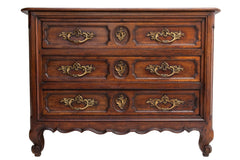 The Languedoc has long been overshadowed by its neighbor Provence., but the furniture from this region around the city of Nimes is as rich in materials and design as those across the border in Arles. Here too, influences of the heavier Spanish Catalan style may be found, but richly curved and rounded pieces in the Louis XV style are prominent. One can find the panetière here but not the pétrin. Commodes were produced in great numbers and in a variety of styles from rustic to bourgeois. The elaborate shell cartouche provides a focal point of design in buffet, commode, and armoire, alike with carving running the full length of the lower traverse.
The Languedoc has long been overshadowed by its neighbor Provence., but the furniture from this region around the city of Nimes is as rich in materials and design as those across the border in Arles. Here too, influences of the heavier Spanish Catalan style may be found, but richly curved and rounded pieces in the Louis XV style are prominent. One can find the panetière here but not the pétrin. Commodes were produced in great numbers and in a variety of styles from rustic to bourgeois. The elaborate shell cartouche provides a focal point of design in buffet, commode, and armoire, alike with carving running the full length of the lower traverse.
Auvergne
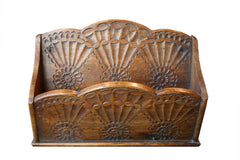 The isolation of this region of mountains and forests resulted in a rugged individuality of the augergnat pieces. Carving is deep and straight. Typical decorations of the region include zigzags, lozenges, rosettes, checkers, stars, and geometric patterns. Although fruitwood was preferred, red walnut was most often chosen for furniture-making along with chestnut. The area around Velay is noted for cherry, apple, pear, and lime. Beech was reserved for chair-making.
The isolation of this region of mountains and forests resulted in a rugged individuality of the augergnat pieces. Carving is deep and straight. Typical decorations of the region include zigzags, lozenges, rosettes, checkers, stars, and geometric patterns. Although fruitwood was preferred, red walnut was most often chosen for furniture-making along with chestnut. The area around Velay is noted for cherry, apple, pear, and lime. Beech was reserved for chair-making.
Buffets are numerous in this region, both single and a deux corps. The low ceilings of the Auvergnat homes often meant that proportions were adjusted to give more width and less height in the armoires of the region. The stylistic influences of the court were late in their assimilation by the local artisans. Thus the pieces of the region are dominated by the regional geometric ornamentation and supplemented by Louis XV feet, fluted Louis XVI columns, and a large protruding Louis XIII cornice.
Provence
 The prosperity of the region led to an opulence at all levels of society that demanded richly decorated furniture to match. The furniture from Provence is among the most appealing to come out of France. The Louis XV style was met with exuberance by the local artisans and their unrestrained yet skilled furniture-making is found in their range of buffets and armoires as well as in their numerous smaller pieces with specific functions.
The prosperity of the region led to an opulence at all levels of society that demanded richly decorated furniture to match. The furniture from Provence is among the most appealing to come out of France. The Louis XV style was met with exuberance by the local artisans and their unrestrained yet skilled furniture-making is found in their range of buffets and armoires as well as in their numerous smaller pieces with specific functions.
The pieces from Arles are elaborate with ornate carvings, curved lines, and rich details. Low-relief carving of garlands, roses, flower, buds, and olive branches abound. The style of Fourques is less decorated and more architectural in appearance.
The wood of the region had a rich, glowing, honey-toned patina which would only improve with age. Light, golden walnut was favored along with local exotic woods such as olive wood, pear, willow, cherry, chestnut, and mulberry.
The armoires of Provence are richly decorated with two or sometimes three panels per door and lavishly carved borders. Ornate metalwork ran from top to bottom of the doors and lacy, symmetrical escutcheons were placed one on top of the other along the length of doors and drawers.
 The furniture of Provence includes pieces that were unique to this part of France. The buffet a glissant is a two tiered buffet from Haute Provence and features a traditional buffet base topped by a small, separate upper section with two sliding doors. This design was conceived so that glasses could be taken out of the top part without disturbing vases or containers sitting on the buffet top. The encoignure is a tall, narrow, three-sided cabinet, sometimes bow fronted, made specifically to be placed in the corner of a room.
The furniture of Provence includes pieces that were unique to this part of France. The buffet a glissant is a two tiered buffet from Haute Provence and features a traditional buffet base topped by a small, separate upper section with two sliding doors. This design was conceived so that glasses could be taken out of the top part without disturbing vases or containers sitting on the buffet top. The encoignure is a tall, narrow, three-sided cabinet, sometimes bow fronted, made specifically to be placed in the corner of a room.
The Provencal kitchen held many unique pieces of furniture. The manjadou or garde-manger is a one-piece cupboard with a single door. The top half of the door has elaborately turned spindles to allow the air to circulate inside around the food stored inside. The panetière, or bread box, is a richly ornamented little cupboard on small legs, with escargot feet. Its front has turned spindles similar to the manjadou. Its purpose is to hold freshly baked bread and it is usually hung on the wall. The pétrin, or dough table, is a trough shaped chest with a hinged top and carved legs. Its role in life is to store kneaded bread while rising. The elaborately hand-carved salière was used for storing salt and the farinière for flour. Small shelves were also popular such as the verrier for glasses and the estagnié for pewter, and the coutelière for knives. All were self-contained units with bordered shelf fronts.
The commode from Provence is distinguished by its curved front and elaborate carving. The radassié is a rush seated banquette built like three or four chairs side by side with arms at either end. It was generally placed near the fireplace.
Lyons, Dauphiné, and Savoy
 The artisans of Lyon directed their attention to small tables in various forms, including bedside tables, work tables, games tables, and reading tables. An Italian influence is seen in the very decorative two drawer commode. Walnut is the most popular wood.
The artisans of Lyon directed their attention to small tables in various forms, including bedside tables, work tables, games tables, and reading tables. An Italian influence is seen in the very decorative two drawer commode. Walnut is the most popular wood.
A specialty of the dauphinois region worth noting is the black varnish used to accentuate moldings and other key lines of a piece.
The Alpine pine trees of the Savoy region were used to produce rustic, primitive furniture with simple outlines.
Burgundy, Bresse, and Franche-Comté
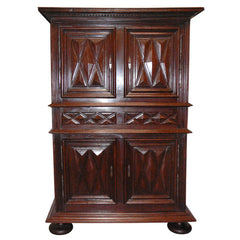
The Burgundy region, world-renown for its wines, is a dichotomy in its furniture design. To the North, the lines are more architectural with geometrical patterns while to the South, some marquetry and the use of contrasting woods display a more vibrant approach.
The Burgundy armoire often has bun feet. In Bresse, three panels per door were used and were made from contrasting woods such as walnut and burr ash. Buffets are often tall and sometimes in Burgundy have a clock positioned under the cornice. A region known for eating well, the buffet vaisselier is more popular than the armoire. The pivoting table was also widely made in Burgundy. The base often had a lyre shape. It is sometimes called a vendange table due to its use for outdoor meals during the grape harvest. This type of table was a space saver as it could be placed out of the way against a wall when not in use.
Alsace and Lorraine
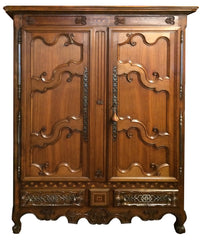 Louis XV is the dominant influence on the local furniture in this picturesque region near the German border. However, the emphasis is less on ornamentation than on mixed woods, interesting graining and burr finishes. The Lorraine decoration is marquetry which was used to highlight motifs such as stars, crosses, rosettes, swastikas and garlands. Armoires were normally made with two doors and two drawers.
Louis XV is the dominant influence on the local furniture in this picturesque region near the German border. However, the emphasis is less on ornamentation than on mixed woods, interesting graining and burr finishes. The Lorraine decoration is marquetry which was used to highlight motifs such as stars, crosses, rosettes, swastikas and garlands. Armoires were normally made with two doors and two drawers.
Ardennes and Champagne
Furniture from the Ardennes and Champagne has a robust quality emphasized by the widespread use of oak in preference to walnut. Narrow door panels were favored and decoration was kept to a minimum. Straight lines were preferred to curved ones and carving was normally in light relief.
Armoires were well proportioned with double doors and a large drawer at the base. Simple marquetry was used for decoration, often featuring a star or stars as in the Lorraine pieces.
The dresser, called le ménager in this region, is a popular piece of furniture and is made of fruitwood in Champagne and oak in the Ardennes. The base contains three molded doors with three drawers above. Above it the rack has three shelves supported by turned balustrades and edged by a molded rim to hold the plates.
Picardy and Flanders
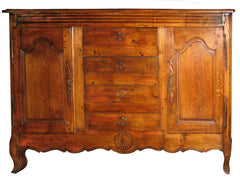 The furniture of France's northeastern-most corner is distinguished by a taste for rich Gothic and Renaissance style ornamentation. The carving of the pieces here was influenced by the work of their neighbors in Belgium and Germany. The pieces of furniture particular to this region include the ribbank, a two-door cupboard, the spinder, a food cupboard, and the dresche, a type of buffet. The traite is a long buffet, sometimes with eight doors, that is found in Picardy. The armoires here are known as presses. Farmhouse tables featured heavily turned legs in the Renaissance styles, and circular drop-leaf tables were also made in Flanders. Another specialty piece of the region is the égouttoir, an open trough on four feet sometimes with a shelf underneath. It is a combined draining board and decorative display unit intended for large kitchens.
The furniture of France's northeastern-most corner is distinguished by a taste for rich Gothic and Renaissance style ornamentation. The carving of the pieces here was influenced by the work of their neighbors in Belgium and Germany. The pieces of furniture particular to this region include the ribbank, a two-door cupboard, the spinder, a food cupboard, and the dresche, a type of buffet. The traite is a long buffet, sometimes with eight doors, that is found in Picardy. The armoires here are known as presses. Farmhouse tables featured heavily turned legs in the Renaissance styles, and circular drop-leaf tables were also made in Flanders. Another specialty piece of the region is the égouttoir, an open trough on four feet sometimes with a shelf underneath. It is a combined draining board and decorative display unit intended for large kitchens.
Ile-de-France
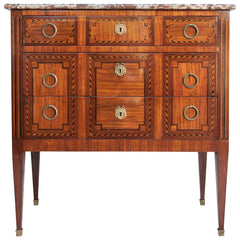 This region is sometimes described as "the garden of Paris" because this area surrounding Paris supplied the capital city were food and goods over many centuries. The local artisans were greatly influenced the the styles and techniques of the cabinet makers in nearby Paris. The result was a degree of perfection in construction, shape and finish which was remarkable when compared to the craftsmen in more isolated provinces. The goal was to produce strong, honest furniture that could survive in the more modest homes and farmhouses of the region. The furniture of the Ile-de-France is the hardest to distinguish since all types of furniture were made here and in a range of fruit and forest woods. Louis XV influences predominated, and the skill of the artisans is seen in a touch of additional sturdiness that singles out a good country piece. What we find here is an urban influence with a provincial execution.
This region is sometimes described as "the garden of Paris" because this area surrounding Paris supplied the capital city were food and goods over many centuries. The local artisans were greatly influenced the the styles and techniques of the cabinet makers in nearby Paris. The result was a degree of perfection in construction, shape and finish which was remarkable when compared to the craftsmen in more isolated provinces. The goal was to produce strong, honest furniture that could survive in the more modest homes and farmhouses of the region. The furniture of the Ile-de-France is the hardest to distinguish since all types of furniture were made here and in a range of fruit and forest woods. Louis XV influences predominated, and the skill of the artisans is seen in a touch of additional sturdiness that singles out a good country piece. What we find here is an urban influence with a provincial execution.
Source: Ruddy, Robin. French Provincial Furniture. Atglen, PA: Schiffer Publishing Ltd., 1998.




